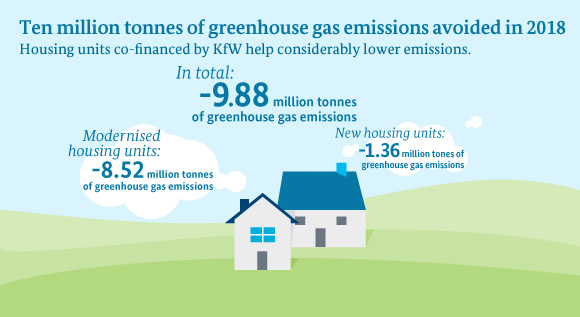Energy-efficient homes: 10 million tonnes of greenhouse gases avoided in 2018
In 2018, some ten million tonnes of greenhouse gas emissions were successfully prevented thanks to energy-efficient housing constructed and/or modernised over the past 13 years, with co-funding from the Ministry. The funding provided via KfW also pays off financially.
 © Federal Ministry of Economic Affairs and Energy; based on data provided by KfW Banking Group
© Federal Ministry of Economic Affairs and Energy; based on data provided by KfW Banking Group
Nearly ten million tonnes of greenhouse gases were avoided in 2018, thanks to funding for energy-efficient housing construction and modernisation provided by KfW. Just to put this figure into perspective: it is more than the entire emissions of Luxembourg.
For 13 years now, the Federal Ministry for Economic Affairs has been supporting citizens as they have had energy-efficient housing built or modernised. The funding, which was provided through the state-owned promotional bank KfW, was used to build or modernise a total of 5.4 million housing units between 2006 and 2018. In 2018, three quarters of these cases were for modernising housing units, the remainder for new construction.
In addition to this, between 2007 and 2018, financing for energy-efficiency retrofits was provided for more than 3,300 buildings used for social and municipal purposes, including schools and kindergartens. This helped prevent another 408,000 tonnes of greenhouse gas emissions in 2018. Since 2015, funding has also been available for making commercial buildings energy-efficient. So far, more than 4,700 buildings have been modernised or built in line with energy-efficiency standards. In 2018, this work led to the prevention of another 408,400 tonnes of greenhouse gas emissions.
Electricity and heat energy consumption is falling
Funding is made available on condition that the building will be much more energy-efficient than is required by law (Energy Conservation Ordinance). House owners, municipalities and companies subscribing to this can access the funding. The work pays off not only in terms of lower greenhouse gas emissions, but also financially, given that the buildings will consume less electricity and energy for heating.
Everyone who has a building constructed to be energy-efficient in this way or who decides to modernise a building can access KfW’s low-interest loans and grants. The funding is provided from the budget for the CO2 Building Rehabilitation Programme and the Ministry’s Energy Efficiency Incentive Programme. In 2018 alone, more than €2 billion in financing was approved for this purpose.
Greenhouse gas emissions avoided – this is how to calculate the amount
The amount of emissions generated by the housing unit prior to the modernisation is compared to the emissions levels after completion of the work. In the case of new buildings, the actual emissions levels are compared to the amounts that would have been generated had the building been constructed in line with the weaker standards set out in the Energy Conservation Ordinance. The difference is equivalent to the amount of greenhouse gas emissions that have been avoided. This is true not only of CO2, but also of other greenhouse gases. With more and more housing units thus rendered more efficient every year, the positive impact of the funding in terms of greenhouse gases avoided is also growing.
But what is the effect in terms of a single housing unit? On average, a housing unit that was rendered more energy efficient in 2018 will emit 1.75 tonnes of greenhouse gases less than prior to the modernisation work. This is equivalent to the amount of greenhouse gas emissions generated by a new car over 13,700 km.
The buildings sector accounts for approximately one third of Germany’s total greenhouse gas emissions. Around two thirds of the country’s housing stock was built prior to 1979, the year in which the first Thermal Insulation Ordinance came into force. Having as many as possible of these houses undergo energy-efficient retrofitting is absolutely key to Germany’s efforts to attain its energy and climate targets.

